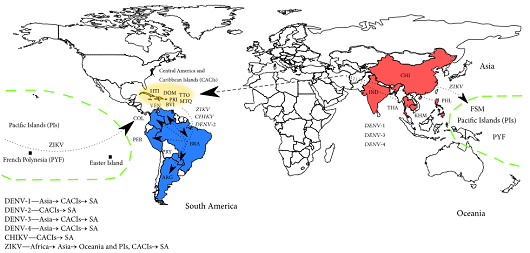Study reveals zika virus entry routes in Brazil
15/10/2018
Solange Argenta (Fiocruz Pernambuco)
A study conducted by Fiocruz Pernambuco reveals how zika virus got to Brazil, filling a gap in the literature addressing this topic. Among the most frequent hypotheses, the virus was believed to have been introduced in Brazil during the 2014 World Cup (June 12th to July 13th), brought by African travelers. Another theory said the virus had been introduced during the world canoeing championship held in August 2014, in Rio de Janeiro, that welcomed competitors from several Pacific countries affected by zika virus.
However, according to the Revisiting Key Entry Routes of Human Epidemic Arboviruses into the Mainland Americas through Large-Scale Phylogenomics study, zika virus, originated in French Polynesia, did not come straight from this country to Brazil. Before that, it migrated to Oceania, then to the Easter Island - from where it was taken to Central America and Caribbean - and only then it got to Brazil, in the end of 2013. “This coincides with the route taken by dengue and chikungunya viruses”, explains one of the investigators, researcher Lindomar Pena. This result indicates that Central America and the Caribbean are important entry routes of arboviruses to South America. And, according to the paper, this is a relevant piece of information for epidemiological surveillance and for the control and monitoring of such diseases, especially on the border with other countries, and ports and airports.

Route map of arboviruses assessed in the study. The colors and arrows highlight the entry routes of DENV, CHIKV, and ZIKV into mainland South America. On the bottom left, there is a summary of routes traced in the study. Abbreviations: ARG: Argentina; BRA: Brazil; BVI = British Virgin Island; CHI: CACIs: Central America and Caribbean islands; China; COL: Colombia; DOM: Dominican Republic; FSM: Federated States of Micronesia; HTI: Haiti; IND: India; KHM: Cambodia; MTQ: Martinique; PIs: Pacific Islands; PER: Peru; PHL: Philippines; PRI: Puerto Rico; PRY: Paraguay; PYF: French Polynesia; SA: South America; THA: Thailand; TTO: Trinidad and Tobago; VEN: Venezuela.
In all Brazilian cases investigated, the virus common ancestral is a strain from Haiti, a country known to be affected by the triple zika, dengue and chikungunya epidemics. Illegal immigrants from Haiti and Brazilian military forces working in Haiti in a peacekeeping mission may have brought zika virus to Brazil. In line with these results, previous studies have confirmed cases of chikungunya in Brazil imported from Haiti and the Dominican Republic, considering Central America and the Caribbean as important entry routes of this arbovirus to Brazil.
The study also concluded that zika virus was introduced to Brazil in multiple independent occasions. This changes the previous idea that one single patient could have brought the disease which then would have spread across the country.
Methodology
The study had the participation of Fiocruz Pernambuco researchers Lindomar Pena, Túlio Campos, Gabriel Wallau, and Antonio Rezende, and of one collaborator from the University of Glasgow, Alain Kohl. The analyses were based on a total of 4,035 complete genome samples from the three viruses available in public databases. Algorithms and modern computer tools were used. The study was funded by Fundação de Amparo à Ciência e Tecnologia do Estado de Pernambuco - Facepe (State of Pernambuco Foundation for Science and Technology) and also involved dengue and chikungunya viruses. The results were published in the International Journal of Genomics.




